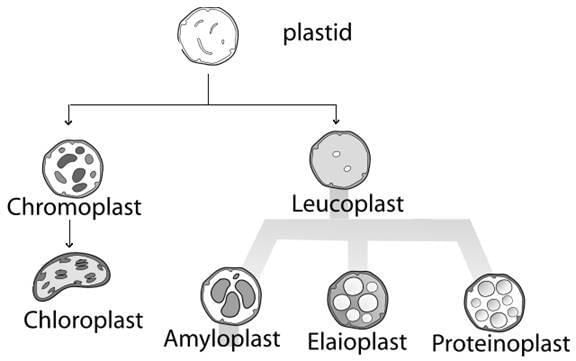NEET Exam > NEET Questions > Elaioplasts belongs toa)Chloroplastb)Leucopla...
Start Learning for Free
Elaioplasts belongs to
- a)Chloroplast
- b)Leucoplast
- c)Amyloplast
- d)Chromoplast
Correct answer is option 'B'. Can you explain this answer?
| FREE This question is part of | Download PDF Attempt this Test |
Verified Answer
Elaioplasts belongs toa)Chloroplastb)Leucoplastc)Amyloplastd)Chromopla...
The leucoplasts are the colourless plastids of varied shapes and sizes with stored nutrients. Leucoplast includes: a) Amyloplasts storing carbohydrates. b) Elaioplastsstoring oils and fats and c) Aleuroplasts storing proteins.
Most Upvoted Answer
Elaioplasts belongs toa)Chloroplastb)Leucoplastc)Amyloplastd)Chromopla...

Free Test
FREE
| Start Free Test |
Community Answer
Elaioplasts belongs toa)Chloroplastb)Leucoplastc)Amyloplastd)Chromopla...
Elaioplasts belongs to Leucoplast.
Elaioplasts are a type of plastid that belong to the category of leucoplasts. Leucoplasts are colorless plastids found in plant cells that are not involved in photosynthesis. They are involved in the synthesis and storage of various substances. Elaioplasts specifically play a role in the synthesis and storage of lipids, mainly oils and fats.
Leucoplasts:
Leucoplasts are one of the three main types of plastids found in plant cells, along with chloroplasts and chromoplasts. They are non-pigmented and can be classified into various subtypes based on their function and content. Leucoplasts are primarily involved in the storage of starch, lipids, or proteins. They can be further categorized into amyloplasts, elaioplasts, and proteinoplasts.
Elaioplasts:
Elaioplasts are a type of leucoplasts that specifically store and synthesize lipids. They are commonly found in plant tissues that require a large amount of oil or fat storage, such as seeds and fruits. Elaioplasts contain enzymes involved in lipid synthesis and are responsible for the production of oils and fats. These lipids are important for energy storage, membrane formation, and as signaling molecules.
Function of Elaioplasts:
1. Lipid Synthesis: Elaioplasts contain enzymes such as acyltransferases and acyl-CoA synthetases that are involved in the synthesis of lipids. These lipids are stored in the form of oil droplets within the plastid.
2. Lipid Storage: Elaioplasts serve as storage organelles for lipids, primarily oils and fats. The accumulated lipids are stored in the form of oil bodies or plastoglobuli within the plastid. These stored lipids can be utilized during seed germination or for energy production in plant cells.
3. Fatty Acid Modification: Elaioplasts also play a role in the modification of fatty acids. They contain enzymes involved in fatty acid elongation, desaturation, and other lipid modifications. These modifications are important for the diversification of lipids and their functions in various cellular processes.
In conclusion, elaioplasts are a type of leucoplasts that specialize in the synthesis and storage of lipids. They are responsible for the production of oils and fats in plant cells and are commonly found in tissues that require lipid storage, such as seeds and fruits.
Elaioplasts are a type of plastid that belong to the category of leucoplasts. Leucoplasts are colorless plastids found in plant cells that are not involved in photosynthesis. They are involved in the synthesis and storage of various substances. Elaioplasts specifically play a role in the synthesis and storage of lipids, mainly oils and fats.
Leucoplasts:
Leucoplasts are one of the three main types of plastids found in plant cells, along with chloroplasts and chromoplasts. They are non-pigmented and can be classified into various subtypes based on their function and content. Leucoplasts are primarily involved in the storage of starch, lipids, or proteins. They can be further categorized into amyloplasts, elaioplasts, and proteinoplasts.
Elaioplasts:
Elaioplasts are a type of leucoplasts that specifically store and synthesize lipids. They are commonly found in plant tissues that require a large amount of oil or fat storage, such as seeds and fruits. Elaioplasts contain enzymes involved in lipid synthesis and are responsible for the production of oils and fats. These lipids are important for energy storage, membrane formation, and as signaling molecules.
Function of Elaioplasts:
1. Lipid Synthesis: Elaioplasts contain enzymes such as acyltransferases and acyl-CoA synthetases that are involved in the synthesis of lipids. These lipids are stored in the form of oil droplets within the plastid.
2. Lipid Storage: Elaioplasts serve as storage organelles for lipids, primarily oils and fats. The accumulated lipids are stored in the form of oil bodies or plastoglobuli within the plastid. These stored lipids can be utilized during seed germination or for energy production in plant cells.
3. Fatty Acid Modification: Elaioplasts also play a role in the modification of fatty acids. They contain enzymes involved in fatty acid elongation, desaturation, and other lipid modifications. These modifications are important for the diversification of lipids and their functions in various cellular processes.
In conclusion, elaioplasts are a type of leucoplasts that specialize in the synthesis and storage of lipids. They are responsible for the production of oils and fats in plant cells and are commonly found in tissues that require lipid storage, such as seeds and fruits.
Attention NEET Students!
To make sure you are not studying endlessly, EduRev has designed NEET study material, with Structured Courses, Videos, & Test Series. Plus get personalized analysis, doubt solving and improvement plans to achieve a great score in NEET.

|
Explore Courses for NEET exam
|

|
Similar NEET Doubts
Elaioplasts belongs toa)Chloroplastb)Leucoplastc)Amyloplastd)ChromoplastCorrect answer is option 'B'. Can you explain this answer?
Question Description
Elaioplasts belongs toa)Chloroplastb)Leucoplastc)Amyloplastd)ChromoplastCorrect answer is option 'B'. Can you explain this answer? for NEET 2024 is part of NEET preparation. The Question and answers have been prepared according to the NEET exam syllabus. Information about Elaioplasts belongs toa)Chloroplastb)Leucoplastc)Amyloplastd)ChromoplastCorrect answer is option 'B'. Can you explain this answer? covers all topics & solutions for NEET 2024 Exam. Find important definitions, questions, meanings, examples, exercises and tests below for Elaioplasts belongs toa)Chloroplastb)Leucoplastc)Amyloplastd)ChromoplastCorrect answer is option 'B'. Can you explain this answer?.
Elaioplasts belongs toa)Chloroplastb)Leucoplastc)Amyloplastd)ChromoplastCorrect answer is option 'B'. Can you explain this answer? for NEET 2024 is part of NEET preparation. The Question and answers have been prepared according to the NEET exam syllabus. Information about Elaioplasts belongs toa)Chloroplastb)Leucoplastc)Amyloplastd)ChromoplastCorrect answer is option 'B'. Can you explain this answer? covers all topics & solutions for NEET 2024 Exam. Find important definitions, questions, meanings, examples, exercises and tests below for Elaioplasts belongs toa)Chloroplastb)Leucoplastc)Amyloplastd)ChromoplastCorrect answer is option 'B'. Can you explain this answer?.
Solutions for Elaioplasts belongs toa)Chloroplastb)Leucoplastc)Amyloplastd)ChromoplastCorrect answer is option 'B'. Can you explain this answer? in English & in Hindi are available as part of our courses for NEET.
Download more important topics, notes, lectures and mock test series for NEET Exam by signing up for free.
Here you can find the meaning of Elaioplasts belongs toa)Chloroplastb)Leucoplastc)Amyloplastd)ChromoplastCorrect answer is option 'B'. Can you explain this answer? defined & explained in the simplest way possible. Besides giving the explanation of
Elaioplasts belongs toa)Chloroplastb)Leucoplastc)Amyloplastd)ChromoplastCorrect answer is option 'B'. Can you explain this answer?, a detailed solution for Elaioplasts belongs toa)Chloroplastb)Leucoplastc)Amyloplastd)ChromoplastCorrect answer is option 'B'. Can you explain this answer? has been provided alongside types of Elaioplasts belongs toa)Chloroplastb)Leucoplastc)Amyloplastd)ChromoplastCorrect answer is option 'B'. Can you explain this answer? theory, EduRev gives you an
ample number of questions to practice Elaioplasts belongs toa)Chloroplastb)Leucoplastc)Amyloplastd)ChromoplastCorrect answer is option 'B'. Can you explain this answer? tests, examples and also practice NEET tests.

|
Explore Courses for NEET exam
|

|
Suggested Free Tests
Signup for Free!
Signup to see your scores go up within 7 days! Learn & Practice with 1000+ FREE Notes, Videos & Tests.
























